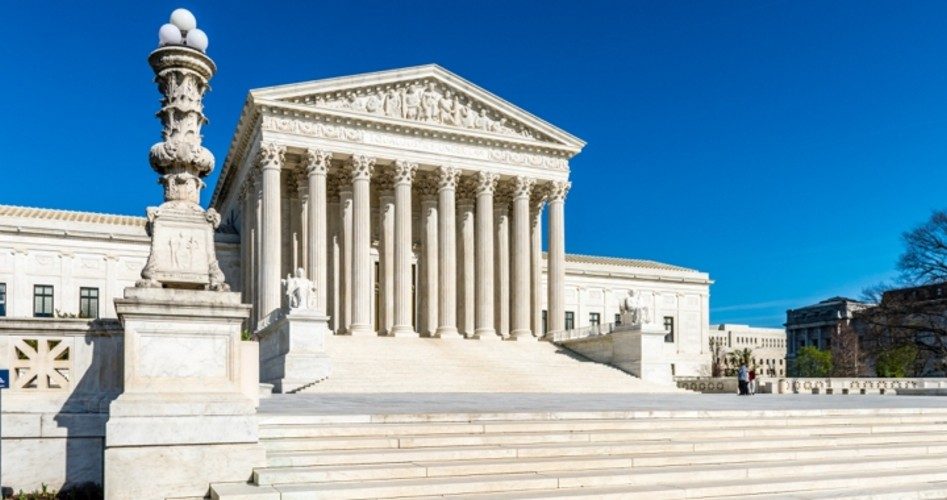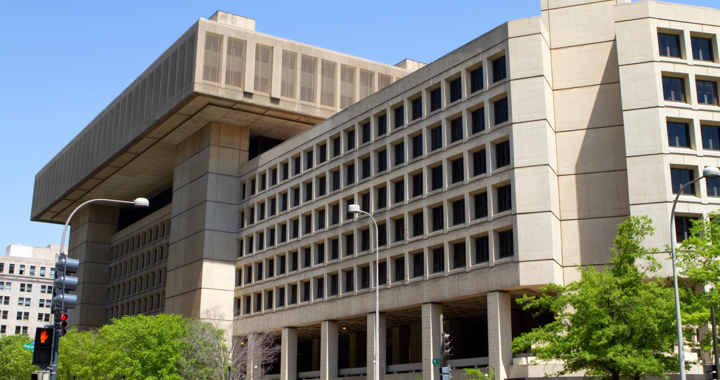
Podcast: Play in new window | Download ()
Subscribe: Android | RSS | More
Since President Trump is a builder by trade, it may not be surprising that he has his eye on federal buildings — not buying them, but beautifying them. At issue is an executive order that would “make the classical style — which originated in ancient Greece and Rome — the default design for federal buildings,” the Los Angeles Times reports.
The order, “Making Federal Buildings Beautiful Again,” was drafted by the nonprofit National Civic Art Society and “would affect the design of any federal building contracted through the General Services Administration that costs more than $50 million,” the Times also relates. The group hopes the president will sign the order, though the White House hasn’t announced a decision.
Trump has in the past criticized the modern building designs that have prevailed the past 60 years or so (e.g., the FBI headquarters in Washington; photo below). He instead favors the classical architecture that dominated America previously, as epitomized by the Supreme Court building (photo above).
 One ardent MABA (Make America Beautiful Again) proponent is Senator Mike Lee (R-Utah). “Classical public buildings are not just piles of stone and glass,” he wrote in the Federalist Friday, advocating the return to American tradition. “They give life to America’s democratic values and republican virtues.”
One ardent MABA (Make America Beautiful Again) proponent is Senator Mike Lee (R-Utah). “Classical public buildings are not just piles of stone and glass,” he wrote in the Federalist Friday, advocating the return to American tradition. “They give life to America’s democratic values and republican virtues.”
The same day the Federalist published an interesting companion piece by Christopher Bedford; he points out that classical architecture in federal buildings was undone via an order in the first place, one titled “Guiding Principles for Federal Architecture” that was drafted by pseudo-elites in 1962. A tumultuous, tradition-rending period, this was the same year school prayer was ruled unconstitutional by a Supreme Court that had become far less American in substance than the building it occupied was in style.
Drafting another order to restore tradition has, unsurprisingly, brought establishment criticism. Outraged, some say the MABA measure is “reminiscent of orders from totalitarian regimes in Nazi Germany and the Soviet Union,” the Times tells us.
Question: What then should we call the ’62 order, which gave us actual buildings reminiscent of the totalitarian Soviet Union?
Having spent much time in Poland, I’ve seen such soulless structures — and how the Poles, like MABA advocates, have rebelled against such architecture. In their case, they often partially paint their drab, grayish, cookie-cutter, commie-disgorged buildings pink and purple to brighten them up. It’s simultaneously cute and curious. But unable to demolish and rebuild half the country, it’s all they can do.
Addressing the pseudo-elite sense of the aesthetic, G.K. Chesterton once quipped, “Savages and modern artists are alike strangely driven to create something uglier than themselves. But the artists find it harder.”
In response some critics may (and in response to the MABA proposal some have) used the old saw, “Beauty is in the eye of the beholder.” But this is a philosophically unsound, self-contradictory statement reflecting the mushy-headed relativism infecting our time.
If “beauty” is actually real — if it has an existence unto itself — then it is what it is, not merely what we perceive it to be (perception can go awry, of course). In this case, the “beholder” proposition is like claiming, “The sun is in the eye of the beholder” and that it’s legitimately the moon or a Fig Newton to some people. Note: This is the same thinking giving us the notion that a boy can be a girl if he thus perceives himself (moral: embracing philosophical error has consequences).
The only other possibility is that “beauty” doesn’t actually exist and at issue is mere taste. If so, then we can’t rightly say, “That woman is beautiful!” (even without #MeToo breathing down our necks) — only that we happen to find her appealing. Either way, the beholder proposition is baby philosophy bunkum.
Speaking of which, the ’62 architectural principles state, “Design must flow from the architectural profession to the government, and not vice versa.” Yet the notion of “letting architects decide architecture” is here a fallacy.
We may see a doctor for a second opinion because we know that “physicians” are not monolithic; some are more qualified than others. Likewise, before the government can let “architects decide architecture” the government must first decide what architects will decide architecture.
It’s as if, instead of having a school board devise curriculum standards, its members said, “We’re going to let educators educate!” and then patted themselves on the back for being open-minded and non-dogmatic — but then proceeded to hire only Marxist teachers. For that matter, they could be conservative or liberal or libertarian teachers, or some combination, too. Picking the educator determines the education — and picking the architect determines the architecture.
So who should be chosen from our nation’s 109,748 architects? It could be members of The Institute of Classical Architecture & Art.
But it’s not. It’s people such as Thom Mayne, of Los Angeles- and N.Y.C.-based Morphosis Architects, “who’s designed three federal buildings in the past three years and consulted on the Sept. 11 Memorial,” as Bedford relates. He actually “told an interviewer on the project, ‘I have no empathy; it doesn’t make me weep. I could make a better case for justifying the terror than the other way around. I’m completely out of sync with America.’”
“This is the same fellow who in 2005, The New York Times called ‘the government’s favorite architect,’” Bedford continues.
But this is the norm today. It’s also reflected in how ex-Weathermen terrorist Bill Ayers, far from being ostracized, makes a fine living devising curricula for America’s schoolchildren. So the government absolutely is choosing architecture (educationally and literally speaking) — it’s just making pseudo-elite choices.
This places in perspective another criticism: The MABA order would constitute censorship. Not only are choices already being made, but such is always the case, whether at issue is religious expression, actual speech, or something else.
Even accepting the fallacious argument that the First Amendment protects all manner and form of “expression,” missed here is that freedom of expression isn’t at all synonymous with government showcasing of expression.
Assuming otherwise has sometimes compelled ignorant (or iniquitous?) officials to allow satanic and “Festivus” displays next to public square Nativity scenes at Christmastime. But consider: Does the fact that Martin Luther King’s words appear in a public square mean that opposing points of view — let’s say, KKK or Nazi sentiments — must accompany them? It’s silly. You can say whatever you want, but not necessarily on the public’s dime.
Likewise, Ugliness 101 architects are free to spend their own cash buying land and erecting an eyesore (local zoning laws are another issue). Entertaining a fantasy of a wholly autonomous architectural oligarchy, however, and having their buildings financed with the people’s money and constructed on what’s essentially the people’s property is a different matter.
It’s not surprising that pseudo-elites such as Thom Mayne, based in L.A. and N.Y.C., would bemoan “flyover country’s” tastes. But in a government of, by, and for the people, the people get to decide on their government — and their government buildings — even if the everyman’s tastes offend elitist sensibilities.
Photo of U.S. Supreme Court: Matt Anderson/iStock/Getty Images Plus; photo of FBI headquarters: sframephoto/iStock/Getty Images Plus
Selwyn Duke (@SelwynDuke) has written for The New American for more than a decade. He has also written for The Hill, Observer, The American Conservative, WorldNetDaily, American Thinker, and many other print and online publications. In addition, he has contributed to college textbooks published by Gale-Cengage Learning, has appeared on television, and is a frequent guest on radio.


